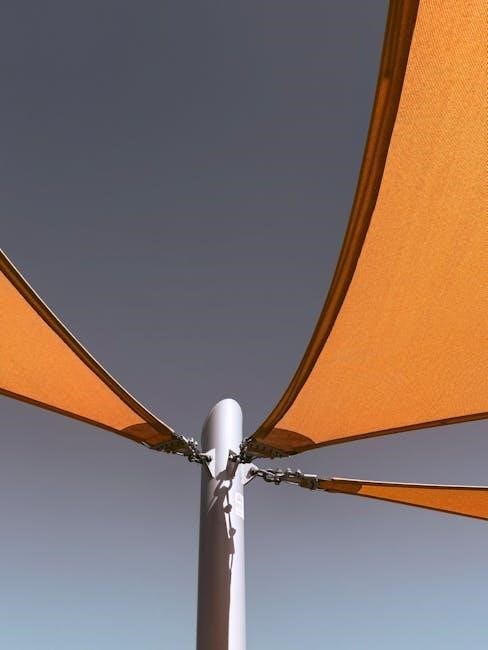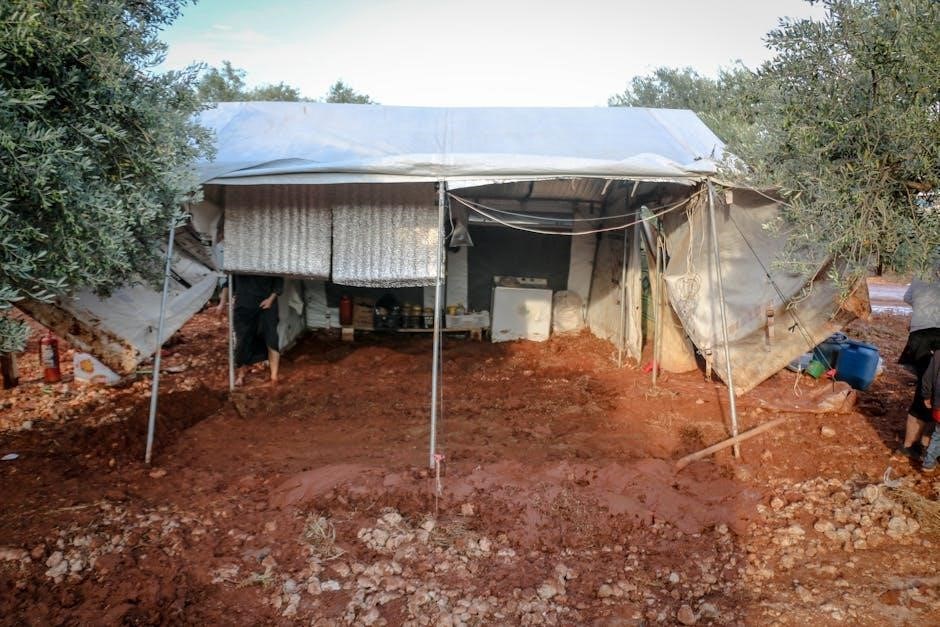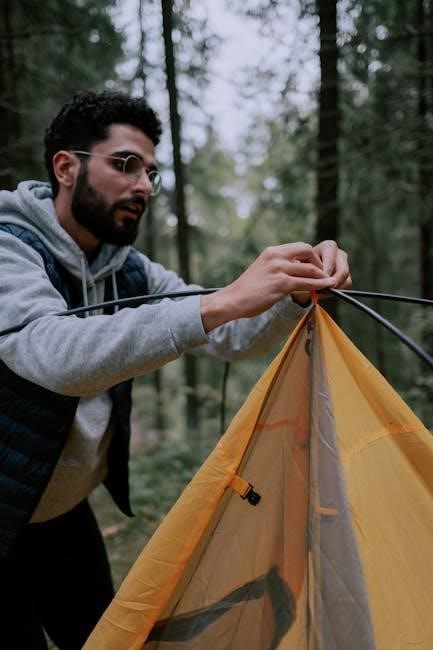A canopy tent is a portable, versatile shelter providing shade and protection for outdoor events. It’s easy to set up and offers a durable, stylish solution for various gatherings; Proper assembly ensures stability and safety, making it essential to follow detailed instructions for a secure and enjoyable experience.

Before You Begin Setting Up Your Canopy Tent
Ensure all components are included and undamaged. Choose a flat, dry location away from overhead obstacles. Clear the area of debris and unpack the hardware for easy access.
Understanding the Components of Your Canopy Tent
Your canopy tent consists of several key components, including the frame, canopy fabric, stakes, ropes, and hardware. The frame typically includes collapsible legs, connectors, and a top rail. The canopy fabric is durable, water-resistant material designed to provide shade. Stakes and ropes secure the tent to the ground, ensuring stability. Hardware pieces like screws, bolts, and connectors are essential for assembling the frame. Familiarizing yourself with these components is crucial for efficient setup and ensuring all parts are accounted for before you begin.
Preparing the Setup Location
Before setting up your canopy tent, ensure the location is clear of debris and obstacles. Choose a flat, level surface for stability. Check for underground utilities and avoid uneven ground. Remove sharp objects to prevent damage. For soft surfaces like grass, use reinforced stakes, and for hard surfaces like concrete, consider sandbags or weights. Ensure proper drainage to prevent water pooling. Verify local regulations for permits or restrictions. Maintain ample space around the tent for safe access and movement. Proper preparation ensures a stable and secure setup, enhancing both safety and functionality.
Step-by-Step Instructions for Setting Up Your Canopy Tent
Start by expanding the frame, then attach the canopy fabric securely. Use stakes and ropes to anchor the tent firmly, ensuring stability and safety during use.
Unpacking and Organizing the Hardware
Start by carefully unpacking all components from the storage bag to avoid damage. Lay out the hardware on a clean, flat surface. Identify and separate the frame pieces, connectors, stakes, ropes, and canopy fabric. Organize the parts into categories for easy access during assembly. Ensure all items are accounted for by cross-referencing with the inventory list provided in the manual. This step ensures a smooth setup process and prevents delays. If any parts appear damaged or missing, contact the manufacturer immediately. Proper organization is key to efficiently assembling your canopy tent. Always refer to the instruction manual for specific hardware identification.
Expanding the Tent Frame
Start by standing over the collapsed tent frame and grip the center hub. Slowly lift and pull outward to expand the frame. Continue expanding until the frame reaches its full size. Ensure all connecting parts click securely into place. Avoid forcing the frame beyond its natural expansion limit, as this may cause damage. Once fully expanded, double-check that all joints are locked and stable. This step ensures the tent frame is properly set up to support the canopy fabric. Make sure the frame stands upright and is evenly balanced before moving on to attaching the fabric.
Attaching the Canopy Fabric to the Frame
Once the frame is fully expanded, align the canopy fabric with the frame’s top connectors. Use the Velcro straps or clips to secure the fabric to the frame, starting from the center and working outward. Ensure the fabric is evenly spread and tightly attached to prevent sagging. Check that all corners are properly aligned and securely fastened. Tighten any adjustable straps to achieve a smooth, wrinkle-free surface. Double-check all connections to ensure stability and durability. This step is crucial for maintaining the tent’s structural integrity and providing optimal shade and protection.
Securing the Tent with Stakes and Ropes
Securing your canopy tent with stakes and ropes is crucial for stability and safety. Start by driving stakes into the ground at a 45-degree angle through the tent’s foot pads. Tighten the ropes firmly to ensure the fabric is taut and wrinkle-free. For added stability, use ropes to tie the top frame corners to nearby stable objects or additional stakes. Regularly inspect the setup to ensure all ropes are tightly secured, especially in windy conditions. Properly anchoring your tent prevents damage and ensures a safe, enjoyable experience for all users.

Maintenance and Cleaning Tips for Your Canopy Tent
Regularly inspect the frame for damage and clean the fabric with mild detergent. Avoid harsh chemicals and ensure the tent is fully dry to prevent mold.
Regular Inspection of the Tent Frame and Fabric
Regular inspection of your canopy tent frame and fabric is crucial for maintaining its durability and performance. Check the frame for rust, dents, or bent parts, and ensure all joints are secure. Inspect the fabric for tears, holes, or fading, and verify that all stitching is intact. Clean the tent periodically to prevent dirt buildup. Store the tent in a dry, cool place when not in use. Addressing minor issues promptly can prevent major damage and extend the tent’s lifespan. Regular maintenance ensures your canopy tent remains safe, functional, and ready for use in various outdoor settings.
Cleaning the Canopy Fabric and Frame
Regular cleaning is essential to maintain the durability and appearance of your canopy tent. Start by brushing off loose dirt from the fabric and frame using a soft-bristle brush. Mix mild detergent with warm water, and gently scrub the fabric using a clean cloth or sponge. Avoid harsh chemicals or bleach, as they may damage the material. For tough stains, apply the solution directly and let it sit before rinsing thoroughly with clean water. For the frame, use a damp cloth to wipe down metal parts, ensuring no rust or corrosion forms. Allow all components to dry completely before storage to prevent mold or mildew. Regular maintenance ensures your canopy tent remains in excellent condition for years to come.

Safety Precautions When Using Your Canopy Tent
Ensure the tent is securely anchored to prevent collapse. Avoid strong winds and rain. Keep flammable materials away. Regularly inspect for damage and wear. Always follow setup instructions carefully to ensure stability and safety during use.
Weather Conditions to Avoid
When using a canopy tent, it’s crucial to avoid severe weather conditions. Strong winds exceeding 25 mph can destabilize the structure, while heavy rain may cause waterlogging. Thunderstorms pose risks of lightning strikes and gusts. Direct sunlight can heat the fabric, potentially causing damage. Always monitor weather forecasts and dismantle the tent if unsafe conditions arise. Ensure the tent is securely anchored and avoid setup in open areas during windy conditions. Proper preparation and awareness of weather risks are essential for safe and enjoyable use of your canopy tent.
Fire Safety Guidelines
Fire safety is crucial when using a canopy tent to prevent accidents. Keep open flames, grills, and candles away from the tent to avoid fabric ignition. Ensure the area is clear of flammable materials. Follow local fire safety regulations and maintain a fire extinguisher nearby. Be cautious with electrical equipment and avoid overheating. Properly secure the tent to prevent it from becoming a fire hazard in windy conditions. Always supervise cooking or heating elements near the tent. Adhere to these guidelines to ensure a safe and enjoyable experience under your canopy tent.

Customizing Your Canopy Tent
Customize your canopy tent with personalized designs, branding, or vibrant colors. Enhance functionality by adding lighting, sidewalls, or decorative accessories for a unique and stylish appearance.
Adding Branding or Personalized Designs
Customizing your canopy tent with branding or personalized designs enhances its visual appeal and makes it stand out. Use high-quality materials like PVC or polyester for printing logos or messages. Ensure designs are printed clearly and securely attached to the fabric. Position branding strategically for maximum visibility. For intricate designs, consider professional services. Regularly inspect and clean the printed areas to maintain durability. Personalized touches like colors or patterns can also reflect your brand or event theme. Follow manufacturer guidelines for attaching designs to avoid damaging the fabric. This step transforms your canopy into a unique and professional-looking shelter for any occasion.
Using Lighting and Accessories
Enhance your canopy tent’s functionality and aesthetics with lighting and accessories. LED lights or fairy lights can illuminate the interior, creating a welcoming ambiance for evening events. Side walls or window panels add privacy and weather protection, while weighted bags or sandbags ensure stability in windy conditions. Customizable accessories like flags or banners can personalize your tent, making it stand out. Additionally, portable tables or shelves maximize space efficiency. Always follow the manufacturer’s guidelines when attaching accessories to ensure safety and maintain the tent’s structural integrity. These additions not only improve comfort but also elevate the overall appearance of your canopy tent setup.
Dismantling and Storing Your Canopy Tent
Dismantling involves carefully removing stakes, detaching fabric, and folding the frame. Store components in a dry, clean area to prevent damage and ensure longevity for future use.
Proper Storage Techniques
Proper storage is crucial for maintaining your canopy tent’s condition. Always clean and dry the tent before storing to prevent mold and damage. Store the frame and fabric separately in sturdy, breathable bags. Keep them in a cool, dry place away from direct sunlight and pests. Ensure all hardware is securely packed to avoid loss. Regularly inspect stored items for signs of wear or damage. This ensures your canopy tent remains in excellent shape for future use. Proper storage extends the lifespan of your tent, ensuring it stays functional and ready for your next event or gathering.
Setting up a canopy tent is a straightforward process when you follow the provided instructions carefully. By understanding the components, preparing the site, and systematically assembling the tent, you ensure stability and safety. Regular maintenance and adherence to safety guidelines will extend the life of your canopy tent and ensure it remains a reliable shelter for outdoor events. Remember to dismantle and store your tent properly after use. With these steps, you’ll enjoy a durable, versatile, and stylish shelter for years to come. Always refer to additional resources if you need further clarification or assistance.
Additional Resources for Canopy Tent Setup
For further guidance, explore instructional videos and detailed manufacturer-specific guides. These resources offer step-by-step instructions, troubleshooting tips, and expert advice to ensure a seamless setup experience.
Instructional Videos and Guides
Instructional videos and guides are invaluable resources for setting up canopy tents. Many manufacturers provide step-by-step videos demonstrating assembly, expansion, and attachment of fabrics. Detailed guides often include real photos and walkthroughs, ensuring clarity for users. These resources cover various tent sizes and styles, from pop-up canopies to larger structures. Videos offer practical tips beyond written instructions, helping users troubleshoot common issues. Additionally, manufacturer-specific guides ensure compliance with safety standards and optimal performance. By utilizing these tools, users can achieve a secure and professional setup, maximizing their tent’s durability and functionality for outdoor events and gatherings.
Manufacturer-Specific Instructions
Manufacturer-specific instructions are tailored to the unique design and features of your canopy tent. These guides often include detailed diagrams, step-by-step videos, and troubleshooting tips. They may highlight specific hardware, such as frames, stakes, and ropes, ensuring proper assembly. Always refer to the manufacturer’s manual for model-specific advice, as components can vary. Following these instructions helps maintain warranty validity and ensures safety. Many manufacturers also provide FAQs and customer support for clarity. Adhering to these guidelines ensures a secure and efficient setup, maximizing your tent’s performance and longevity. They are indispensable for first-time users and seasoned setups alike.

